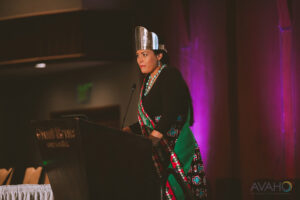
Christina Flint-Lowe, DNPT, ARNP, FNP-BC, A Nurse Practitioner and American Indicant Alaska Native Special Emphasis Program Manager at the VA Bay Pines, FL, Healthcare System Source: Association of VA Hematology and Oncology 2024 annual Meeting
ATLANTA — Native Americans serve in the military at the highest rates per capita of any racial or ethnic group. According to the Office of Health Equity, analysis of fiscal year 2016 to 2019 data revealed that out of approximately 140,000 American Indian veterans, less than half were enrolled in VA care.
But Indigenous veterans in the United States face myriad health challenges often underrecognized by clinicians in the VA, noted Christina Flint-Lowe, DNPT, ARNP, FNP-BC, a nurse practitioner and American Indicant Alaska Native Special Emphasis Program Manager at the VA Bay Pines, FL, Healthcare System at the keynote address on the first day of the 2024 AVAHO annual meeting in Atlanta.
Flint-Lowe also is the 2023-2024 Poarch Creek Indian Senior Adult Princess and ambassador for the Poarch Creek Indians,
The diversity of Native American cultures adds to the complexity of addressing the physical and mental health needs of Indigenous veterans. There are more than 500 federally recognized tribes, hundreds of state-recognized tribes, and numerous tribal groups unaffiliated with any state or federal entity in the U.S., which vary in their languages, traditional appearances, and cultural practices.
This is “one reason why attempting to standardize a single approach to the care of Native Americans is so daunting. Some generic or what we refer to as pan-Indian terms and cultural practices are shared amongst these groups. However, we must not generalize one Native perspective to all Native perspectives,” added Flint-Lowe
Collaborative Efforts Between the IHS and the VA
New collaborative efforts between the VA and the Indian Health Service are paving the way for improved access to care for Indigenous veterans and increasing the need for clinicians in the VA to engage with Native veterans. These arrangements facilitate coordination between organizations, ensuring that IHS policies—such as waiving co-pays, covering medication costs and offering loans to address housing for American Indian veterans—can be effectively integrated into the VA system.
Still, quality measures demonstrate that Native American veterans over the age of 65 do not receive the same preventive care as non-Hispanic white veterans. For colorectal cancer screening, veterans overall exceed the national benchmark of 80% completion, but it was “an astonishing 23% lower for American Indians despite national VA initiatives promoting cancer prevention strategies,” Flint-Lowe noted.
Raising rates for preventive screening and care is complicated by “fear and lack of trust and care for a Western-based medical model,” Flint-Lowe said. This distrust is validated by not just historical experiences, but by events in the last decade that include sterilization of Indigenous women without their consent, misuse of tissues samples in clinical studies, and receiving body bags instead of vaccines and supplies during the COVID pandemic, she added.
To address these concerns amongst Indigenous veterans, Flint-Lowe provided some tips for clinicians:
- Examine Implicit Bias
“It may be necessary to alter previously held biases and perceptions about American Indian people” said Flint-Lowe. Utilize tools like those from the VA Health Equity website to assess your biases and gain insights into how they may affect your interactions. - Build Rapport and Trust
“Rapport and trust do not come easily,” so be prepared for open discussions on sensitive topics. Humor can facilitate rapport; don’t be surprised if community members use humor as a healing tool. Learn to laugh at yourself and accept guidance in a light-hearted manner. - Adapt Communication Styles
Pay attention to and reflect the local community’s communication styles. Observe others to understand their preferences for body language, physical contact, and personal space. - Practice Humility and Listening
“Listen and observe more than you speak,” added Flint-Lowe. Become comfortable with silence and pauses. Acknowledge your own limitations and be open about your knowledge gaps; humility will earn you respect. - Respect Cultural Diversity
Each Indigenous community is unique, with its own cultural norms and practices. Flint-Lowe highlighted the importance of learning how communities prefer to refer to themselves, stating, “We’re not Indian, we’re Muscogee, we’re Chickasaw, we’re Cherokee.” This respect for identity is crucial in establishing effective communication. - Be Aware of Gender Dynamics
Gender roles can vary significantly amongst different tribes. Flint-Lowe suggests careful observation and seeking guidance on appropriate behaviors, as “common behaviors for service providers” may differ. Understanding the influence of elders and the roles of men and women in various contexts is essential.
By following these tips, healthcare providers can foster a more inclusive and respectful environment for Indigenous veterans, ultimately improving trust and care outcomes.


